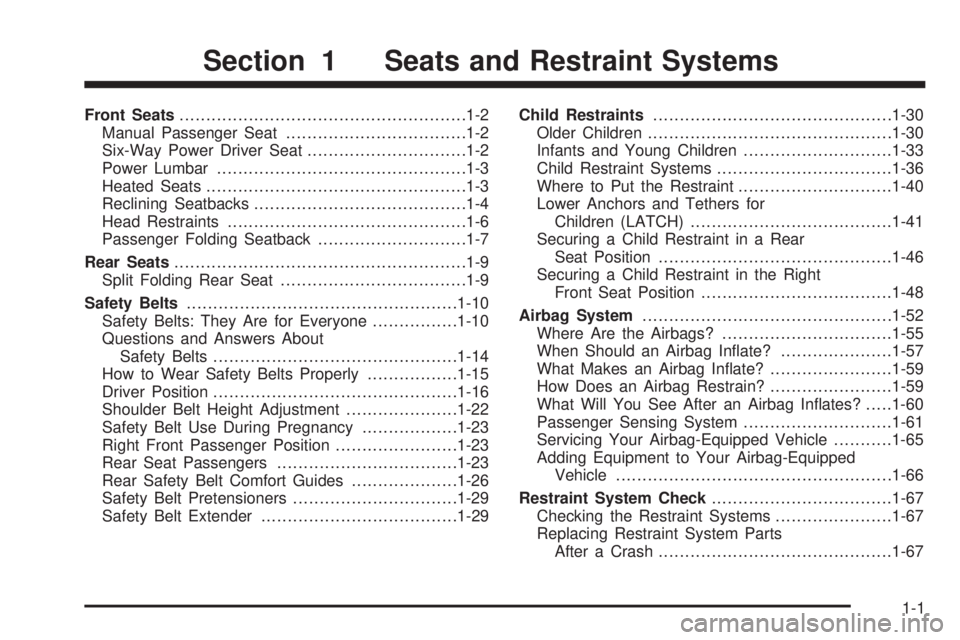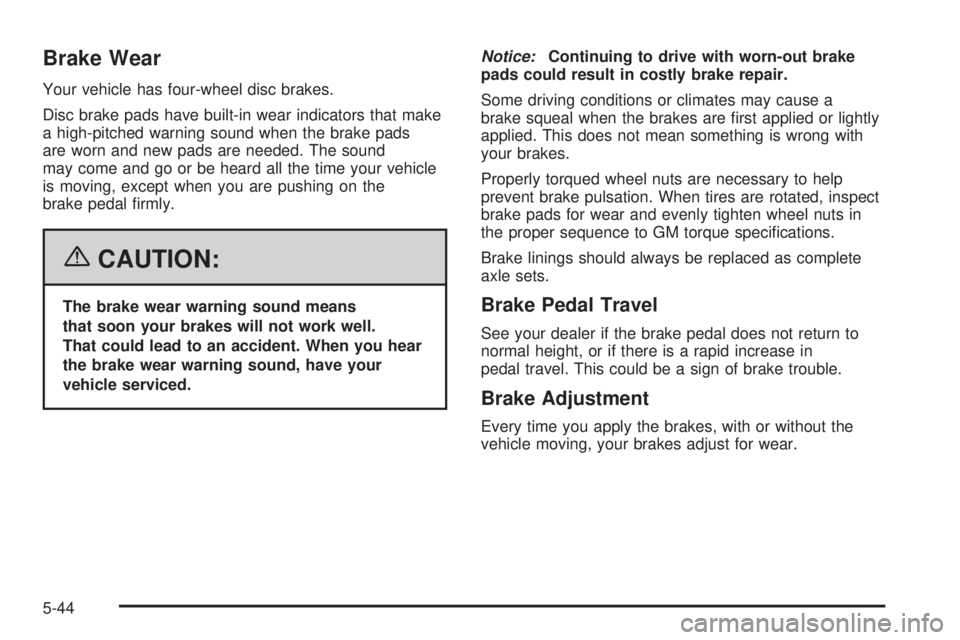Page 7 of 472

Front Seats......................................................1-2
Manual Passenger Seat..................................1-2
Six-Way Power Driver Seat..............................1-2
Power Lumbar...............................................1-3
Heated Seats.................................................1-3
Reclining Seatbacks........................................1-4
Head Restraints.............................................1-6
Passenger Folding Seatback............................1-7
Rear Seats.......................................................1-9
Split Folding Rear Seat...................................1-9
Safety Belts...................................................1-10
Safety Belts: They Are for Everyone................1-10
Questions and Answers About
Safety Belts..............................................1-14
How to Wear Safety Belts Properly.................1-15
Driver Position..............................................1-16
Shoulder Belt Height Adjustment.....................1-22
Safety Belt Use During Pregnancy..................1-23
Right Front Passenger Position.......................1-23
Rear Seat Passengers..................................1-23
Rear Safety Belt Comfort Guides....................1-26
Safety Belt Pretensioners...............................1-29
Safety Belt Extender.....................................1-29Child Restraints.............................................1-30
Older Children..............................................1-30
Infants and Young Children............................1-33
Child Restraint Systems.................................1-36
Where to Put the Restraint.............................1-40
Lower Anchors and Tethers for
Children (LATCH)......................................1-41
Securing a Child Restraint in a Rear
Seat Position............................................1-46
Securing a Child Restraint in the Right
Front Seat Position....................................1-48
Airbag System...............................................1-52
Where Are the Airbags?................................1-55
When Should an Airbag In�ate?.....................1-57
What Makes an Airbag In�ate?.......................1-59
How Does an Airbag Restrain?.......................1-59
What Will You See After an Airbag In�ates?.....1-60
Passenger Sensing System............................1-61
Servicing Your Airbag-Equipped Vehicle...........1-65
Adding Equipment to Your Airbag-Equipped
Vehicle....................................................1-66
Restraint System Check..................................1-67
Checking the Restraint Systems......................1-67
Replacing Restraint System Parts
After a Crash............................................1-67
Section 1 Seats and Restraint Systems
1-1
Page 22 of 472
Driver Position
Lap-Shoulder Belt
The driver has a lap-shoulder belt. Here is how to wear
it properly.
1. Close and lock the door.
2. Adjust the seat so you can sit up straight. To see
how, see “Seats” in the Index.
3. Pick up the latch plate and pull the belt across you.
Do not let it get twisted.The shoulder belt may lock if you pull the belt
across you very quickly. If this happens, let the belt
go back slightly to unlock it. Then pull the belt
across you more slowly.
4. Push the latch plate into the buckle until it clicks.
Pull up on the latch plate to make sure it is secure.
If the belt is not long enough, seeSafety Belt
Extender on page 1-29.
Make sure the release button on the buckle is
positioned so you would be able to unbuckle the
safety belt quickly if you ever had to.
5. Move the shoulder belt height adjuster to the height
that is right for you. SeeShoulder Belt Height
Adjustment on page 1-22.
1-16
Page 28 of 472
To unlatch the belt, just push the button on the buckle.
The belt should go back out of the way.
Before you close the door, be sure the belt is out of the
way. If you slam the door on it, you can damage
both the belt and your vehicle.
Shoulder Belt Height Adjustment
Before you begin to drive, move the shoulder belt height
adjuster to the height that is right for you.
Adjust the height so that the shoulder portion of the
belt is centered on your shoulder. The belt should
be away from your face and neck, but not falling off
your shoulder.
To move it down, pull the
release button (A) out and
move the height adjuster
to the desired position.
You can move the height
adjuster up just by pushing
up on the shoulder
belt guide.
After you move the height adjuster to where you want it,
try to move it down without pulling the release button
to make sure it has locked into position.
1-22
Page 350 of 472

Brake Wear
Your vehicle has four-wheel disc brakes.
Disc brake pads have built-in wear indicators that make
a high-pitched warning sound when the brake pads
are worn and new pads are needed. The sound
may come and go or be heard all the time your vehicle
is moving, except when you are pushing on the
brake pedal �rmly.
{CAUTION:
The brake wear warning sound means
that soon your brakes will not work well.
That could lead to an accident. When you hear
the brake wear warning sound, have your
vehicle serviced.Notice:Continuing to drive with worn-out brake
pads could result in costly brake repair.
Some driving conditions or climates may cause a
brake squeal when the brakes are �rst applied or lightly
applied. This does not mean something is wrong with
your brakes.
Properly torqued wheel nuts are necessary to help
prevent brake pulsation. When tires are rotated, inspect
brake pads for wear and evenly tighten wheel nuts in
the proper sequence to GM torque speci�cations.
Brake linings should always be replaced as complete
axle sets.Brake Pedal Travel
See your dealer if the brake pedal does not return to
normal height, or if there is a rapid increase in
pedal travel. This could be a sign of brake trouble.
Brake Adjustment
Every time you apply the brakes, with or without the
vehicle moving, your brakes adjust for wear.
5-44